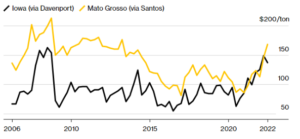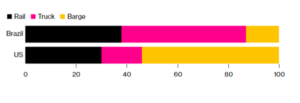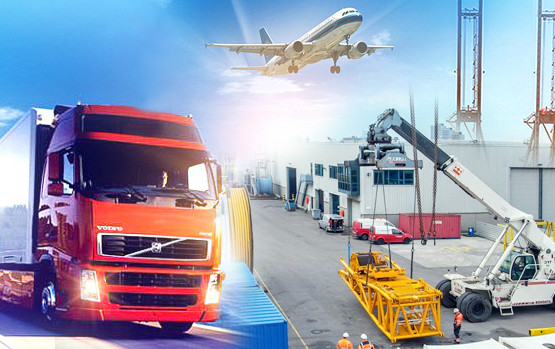Because of supply-chain bottlenecks and a rising dollar, Brazil is the main competitor for US soybean producers in the world market.
Up until 2020, China, the top importer, paid about twice as much to export Brazilian soybeans as opposed to American soybeans.. However, according to data from the US Department of Agriculture, logistical challenges in the US, improvements to the country’s ports and supply systems, and a strong dollar have almost completely closed that deficit.
A ton of soybeans, which are used for everything from animal feed to cooking oils to biofuels, can now be shipped from Mato Grosso, Brazil, at approximately the same price as it would from Iowa, the second-largest producer in the US. And despite this year’s spike in fuel prices, which fueled inflation, the gap has shrunk.
Brazil Narrows Gap With the US on Soybean Transport Costs
shipping soybeans’ cost from Brazil to China is now similar to the US

Source: US Department of Agriculture
Brazil is already beginning to benefit from the more than 290 billion reais ($56.1 billion) the federal government has invested in roads and maritime gateways since 2008, while the US, which competes with Brazil as the world’s largest soybean producer, rushes to address transport backlogs from the pandemic era and launches a multi-billion-dollar plan to upgrade creaky infrastructure.
The Soy Transportation Coalition’s executive director, Mike Steenhoek, asserts that “nothing stimulates more frequently than the competition, and this is a strong struggle.” “When you see that kind of growth in other areas, we need to increase investments in our country.”
Time is of the essence for the US, which lost about $10 billion in agricultural exports as an outcome of supply-chain disruptions during the pandemic, according to a paper published in April by Colin Carter of the University of California at Davis, Sandro Steinbach of the University of Connecticut, and Xiting Zhuang, a doctoral student.
Brazil is reaping the benefits of its investment, as the time and distance required to transport crops from midwestern farms to a ship have been reduced by two days and 1,000 miles, or roughly half, thanks to the renovation of the so-called Northern Arc of ports along the Amazon River and northeastern Atlantic Ocean coast.
The National Confederation of Agriculture and Livestock reports that exports of corn and soy through the Northern Arc have increased by almost six times over the last ten years.
According to Bruno Stupello, the business development director at the gateway, authorities at Santos, Brazil’s busiest port, are investing hundreds of millions of dollars to upgrade total capacity by about 50% to 240 million tons annually in 2040. Meanwhile, the total amount of cargo moved by train will almost double to 86 million tons per year.
According to Thiago Pera, an expert in agricultural logistics at the University of Sao Paulo, for the foreseeable future, Brazil must spend money on infrastructure that expands faster than production.
Concerning the record harvest the USDA anticipates for the 2023 season, he remarked that it “will be a challenge given the output predictions for the next few years.”
There is little doubt that the significant logistics expenditures promised by the 2021 federal infrastructure package in the US include $17 billion for ports and tens of billions more for rail and highways. The nation’s marine hubs and their tenants simultaneously intend to invest over $33 billion yearly by 2025.
Brazil Heavily Relies on Trucks
proportion of soybean exports moved by each mode of transportation.

Source: US Department of Agriculture, University of Sao Paulo
Although there are supply-chain bottlenecks in the US to resolve, compared to Brazil, it is still simpler to transport goods to ports there, according to Steenhoek of the Soy Transportation Coalition.
And even with all the investment, Joana Colussi, an agricultural expert at the University of Illinois in Urbana-Champaign, said that only time will tell if Brazil will establish itself as a less expensive option.
Despite recent improvements, she predicted that Brazil’s logistical problems will likely continue in the years to come due to infrastructure deficiencies.
Brazil’s competitiveness has improved thanks to investments, but it has also benefited from the local currency’s depreciation against the US dollar. Except for the Japanese yen, which has declined 23%, the real has lost nearly 18% of its value against the dollar since the year 2020 began. This is the greatest loss among the 16 major currencies tracked by Bloomberg.
Brazil is undoubtedly more competitive, but there is a significant currency effect, according to Pera of the University of Sao Paulo. “That edge can be lost if things settle down again and the real strengthen, therefore it’s crucial to keep funding significant infrastructure improvement projects.”
According to Peter Friedmann, executive director of the Washington-based Agriculture Transportation Coalition, importers ultimately have more discretion in this case.
The hogs in China consume the soybeans that we export, regardless of whether they are grown in Brazil or Minnesota, he said.
